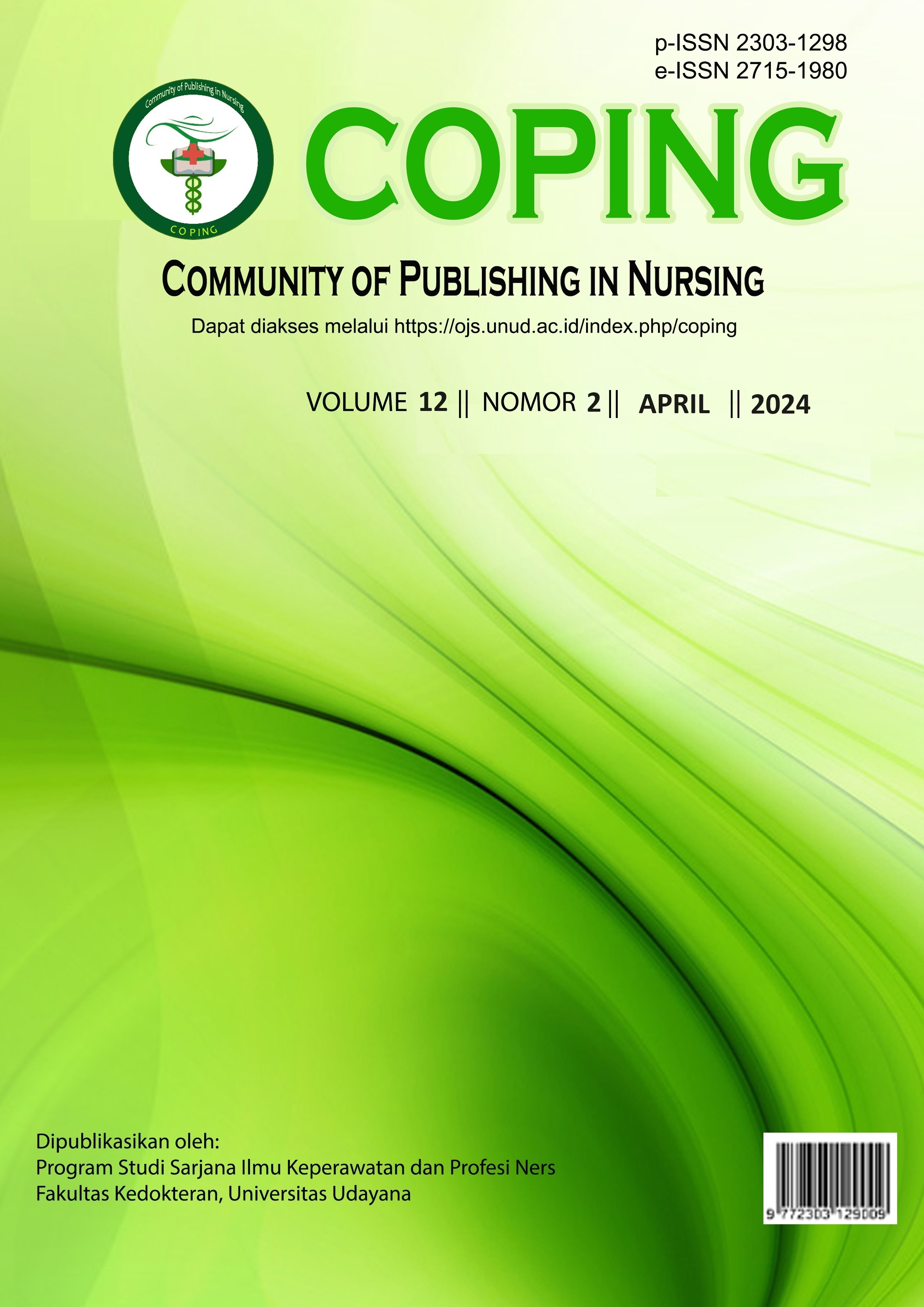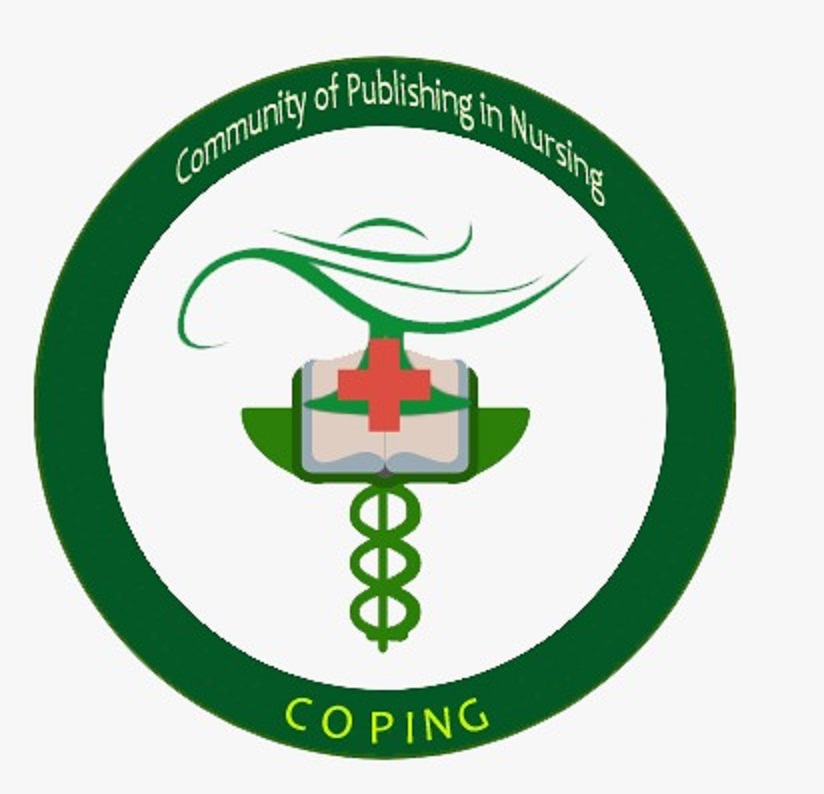RATIONAL EMOTIVE BEHAVIOUR THERAPY BERBASIS TELEPHONE INTERVENTION PROBLEM SOLVING DALAM MENGATASI PERILAKU SELF INJURY PADA REMAJA
Abstract
Remaja yang beresiko melakukan tindakan melukai diri membutuhkan mekanisme koping dalam mengatasi permasalahan yang mereka hadapi. Penggunaan rational emotive behaviour therapy berbasis telephone intervention problem solving merupakan salah satu bentuk telenursing yang berpeluang memfasilitasi remaja yang beresiko melakukan self injury dengan kemudahan akses pelayanannya. Tujuan penelitian ini adalah untuk mengetahui keefektifan rational emotive behaviour therapy berbasis telephone intervention problem solving dalam mengatasi perilaku self injury pada remaja di SMP Negeri Kota Banjarmasin. Penelitian ini menggunakan desain penelitian pre-eksperimental one group pretest postest, dengan sampel sebanyak 35 remaja di SMP Negeri Kota Banjarmasin. Instrumen DASS 21 digunakan untuk mengukur tingkat stres, kecemasan, depresi. Instrumen Self-Harm Inventory (SHI) digunakan untuk mengukur perilaku resiko menyakiti diri. Dalam penelitian ini diberikan intervensi rational emotive behaviour therapy berbasis telephone dengan perlakuan sebanyak 6 sesi selama 2 minggu. Hasil analisis data didapatkan nilai negative rank dengan total 35 yang artinya seluruh nilai dari hasil pretest ke posttest mengalami penurunan dan nilai selisih rata-rata dari hasil pretest ke posttest sebesar 8,46. Nilai significancy didapatkan p-value 0,000 yang artinya terdapat perbedaan antara nilai pretest dan posttest, sehingga dapat disimpulkan bahwa rational emotive behaviour therapy berbasis telephone intervention problem solving efektif dalam mengatasi perilaku self injury pada remaja di SMPN Kota Banjarmasin.
Downloads
References
Bahari, K., Talosig, A. T., & Pizarro, J. B. (2021). Nursing Technologies Creativity as an Expression of Caring: A Grounded Theory Study. Global Qualitative Nursing Research, 8, 2333393621997397. https://doi.org/10.1177/2333393621997397
Insani, M. S., & Savira, S. I. (2023). Studi Kasus : Faktor Penyebab Perilaku Self-Harm Pada Remaja Perempuan Case Study: Causative Factor Self-Harm Behavior in Adolescent Female. Character : Jurnal Penelitian Psikologi, 10(02), 439–454.
Islamiah, N., Daengsari, D. P., & Hartianti, F. (2015). Cognitive Behavior Therapy untuk Meningkatkan Self-Esteem pada Anak Usia Sekolah. Jurnal Ilmu Keluarga Dan Konsumen, 8(3), 142–152. https://doi.org/10.24156/jikk.2015.8.3.142
Jannah, M. (2017). Remaja Dan Tugas-Tugas Perkembangannya Dalam Islam. Psikoislamedia : Jurnal Psikologi, 1(1), 243–256. https://doi.org/10.22373/psikoislamedia.v1i1.1493
Nawaz, R. F., Reen, G., Bloodworth, N., Maughan, D., & Vincent, C. (2021). Interventions to reduce self-harm on in-patient wards: systematic review. BJPsych Open, 7(3), e80. https://doi.org/10.1192/bjo.2021.41
Pebriani, W. H., Hastuti, E. A., & Hartiningsih, S. S. (2020). Hubungan Regulasi Emosi Dengan Kecenderungan Perilaku Self Harm Pada Mahasiswa Sarjana Keperawatan Di Stikes Dharma Husada [STIKes Dharma Husada]. In siakad.stikesdhb.ac.id. https://siakad.stikesdhb.ac.id/repositories/400219/4002190070/ARTIKEL PDF.pdf
Raihani, D., Zakiah Zulva, S., Kalsum, U., & Karyani, U. (2022). Perilaku Self-harm pada Pasien Depresi dengan Gejala Psikotik. Seminar Nasional Psikologi, 2962–2492.
Romas, M. Z. (2012). Self-Injury Remaja Ditinjuau Dari Konsep Dirinya.pdf. Jurnal Psikologi, 8(1), 40–51.
Shafira, A. N., & Hargiana, G. (2022). Self-Harm Behavior pada Mahasiswa Keperawatan (Self-Harm Behavior among Nursing Students). Jurnal Kesehatan, 11(2), 2721–8007.
Sibarani, D. M., Niman, S., & Widiantoro, F. (2021). Self-Harm Dan Depresi Pada Dewasa Muda. Jurnal Keperawatan Jiwa (JKJ): Persatuan Perawat Nasional Indonesia, 9(4), 795–802.
Son, Y., Kim, S., & Lee, J.-S. (2021). Self-Injurious Behavior in Community Youth. International Journal of Environmental Research and Public Health, 18(4). https://doi.org/10.3390/ijerph18041955
Tarigan, T., & Apsari, N. C. (2022). Perilaku Self-Harm Atau Melukai Diri Sendiri Yang Dilakukan Oleh Remaja (Self-Harm or Self-Injuring Behavior By Adolescents). Focus : Jurnal Pekerjaan Sosial, 4(2), 213. https://doi.org/10.24198/focus.v4i2.31405
Verenisa, A., Suryani, & Siati, A. (2021). Gambaran Self-Injury Mahasiswa. Jurnal Ilmu Keperawatan Jiwa, 4(1), 43–56. https://journal.ppnijateng.org/index.php/jikj
WHO. (2021). Kesehatan Mental Remaja. Who.Int. https://www.who.int/news-room/fact-sheets/detail/adolescent-mental-health
Witt, K. G., Hetrick, S. E., Rajaram, G., Hazell, P., Taylor Salisbury, T. L., Townsend, E., & Hawton, K. (2021). Interventions for self-harm in children and adolescents. The Cochrane Database of Systematic Reviews, 3(3), CD013667. https://doi.org/10.1002/14651858.CD013667.pub2

This work is licensed under a Creative Commons Attribution-NonCommercial 4.0 International License.







